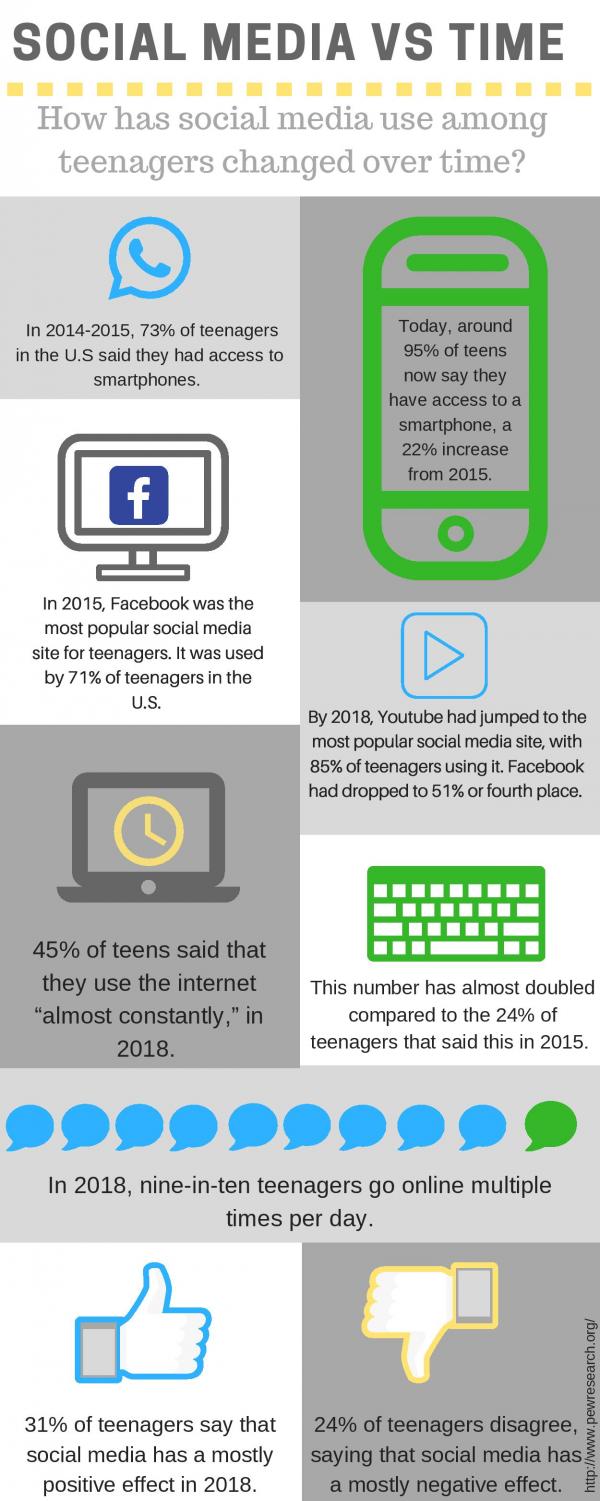EHS’ take on social media usage
October 9, 2018
art by Gillian Mousseau, cover art by Hanna Faris
Quitting social media for the sake of being social
In recent years, teenagers have been automatically associated with social media by older generations. While most do use Snapchat, Instagram, and Twitter regularly, this assumption leaves out about the minority of people who choose to stay away from these platforms.
On December 16th, 2015, I decided to quit social media after Snapchat glitched and deleted my 110 day streak with my best friend. I remember texting my friend in all caps “I quit social media forever!” Aside from a few Instagram posts, my promise has held for almost three years. At the time, the decision seemed rash and unwarranted, but it was a long time coming. I was frustrated by the amount of time that I spent on Snapchat and felt a strong pressure to present a perfect life for everyone on Instagram. No matter how hard I tried to convince myself in middle school, these apps did not give me the fulfillment of real social interaction.
At any get-together with friends, at some point the majority of people are on their phones, mindlessly scrolling or taking selfies. It usually happens when there is a lull in the conversation, as a distraction mechanism to avoid awkwardness. When this happens, I start to feel out of place. With no social media, looking at my phone has no use, and distractions are not as easy to find. If there is one thing that I have learned in the past three years, it is that my friends are just filling seconds the way their brains are trained to do, and they all believe that it is adding something to their lives. Instead of pretending to have something to look at on my phone like I did at first, I have stopped letting the pressure to fill every second with distraction get to me, and use these moments to start up a new conversation instead.
When I tell people that I don’t use social media, most ask if I have a hard time staying up to date with friends. The truth is, turning away from Instagram and Snapchat has led to more conversations about important matters that make me more “up to date” on their real lives, not just their social media facade. I may not have as many followers or snap friends as most people around me, but the relationships I do have are deep and meaningful, and I would not trade that for the world.
How social media affects our perceptions of each other
It’s beyond evident that our generation’s heavy usage of social media is not a passing trend. We check Instagram, emails, Snapchat, Twitter, etc. as if the information is too valuable to omit from our daily lives for even a few hours at a time. Disregarding the aspect of our dependence on it, communication has never been so accelerated and accessible for such a large amount of people. The benefits and detriments of our technological presence are continuously being discussed in contemporary media, yet it is not often looked at only as a change, without necessarily attaching a positive or negative stigma. Whether we like it or not, social media has completely redesigned our interactions as both individuals and members of various communities.
As students, the infatuation with high school popularity is exacerbated by social media followings. EHS sopho mores Liana Hazucha and Lilly Whiteside were able to name several students with large amounts of followers on social media without hesitation, regardless of whether the student claims to be “famous,” or if they neglect to attribute any specific talents to their numbers.
mores Liana Hazucha and Lilly Whiteside were able to name several students with large amounts of followers on social media without hesitation, regardless of whether the student claims to be “famous,” or if they neglect to attribute any specific talents to their numbers.
Not only does social media manipulate the manner in which strangers see each other, but it also plays a large part in friendships and relationships. Many students at EHS use Snapchat as a means of staying in touch with friends, with one student in particular stating that they use the app more often than text messages. Forms of social media that highlight the “social” aspect can also facilitate romantic relationships, especially in a high school setting. Newly developed milestones that are innately accepted by young students—like becoming “Instagram official” and retaining the best friend position on Snapchat for large amounts of time—are widely considered as symbols of a relationship. This evidence counters the argument that social media isolates humans by instead stating that it solely morphs connections, as opposed to annihilating them.
Social media etiquette, defined by the widely accepted norms of politeness for our virtual communication, is also important to interaction in the new age. In our EHS community, the expectation of “following back” is a general principle for students. The thought is that we are all in a similar community and should all stay closely connected by holding interest in each other’s lives. When simplified, it makes comple te sense for members of a community to desire a stronger web of connections; however, our own reception of certain actions impedes simplicity and thus has an effect on how we interact offline. We see those who don’t follow back as mean and consequently put them on a pedestal at our own expense by feeling inferior because of an unreciprocated desire for connection. Yet we see some potential for a deeper connection with those who do follow back, and thus we begin to see how virtual relationships meld into reality.
te sense for members of a community to desire a stronger web of connections; however, our own reception of certain actions impedes simplicity and thus has an effect on how we interact offline. We see those who don’t follow back as mean and consequently put them on a pedestal at our own expense by feeling inferior because of an unreciprocated desire for connection. Yet we see some potential for a deeper connection with those who do follow back, and thus we begin to see how virtual relationships meld into reality.
Most importantly, however, is the way self-image has been skewed by social media dependence. When we see our own social media representation in comparison to others’, the majority either think poorly or too highly of themselves, creating inflated or deflated egos as a result. These comparisons are, for the most part, arranged for most to look small to the bigger, more followed, more poised stars. After all, appearances generally come as a result of the effort they are given, yet we must recognize that these stimuli are not a part of our real world until we allow them to be.
Social media, while both positives and negatives are surely evident, is merely an alteration in the typical lifestyle of those living in more developed societies, causing us to naturally alter our methods of thought and interaction.
Looking ahead: social media in the future
As a society, we’ve come a long way since the first social media platforms have graced the internet. From Six Degrees, an ancient platform of the late 90s, to MySpace in 2003, and Facebook in 2008, social media has changed at a rapid pace. So what does the future hold?
- Facebook will rule us all (no joke).
Facebook is currently the most used social media platform of the modern day, reaching two billion active members in Ju ne. Facebook also happens to own WhatsApp, the most popular messaging app, and Instagram, another popular social media platform. The active user base for each of these platforms is growing by the year, with more and more users fitting a younger demographic. In the next ten years, we will all most likely use at least one of these Facebook-owned platforms, and chances are, we already do! Unless, of course, some hot, new app comes along that totally blows our minds, but let’s be real, Facebook will probably soon own that too.
ne. Facebook also happens to own WhatsApp, the most popular messaging app, and Instagram, another popular social media platform. The active user base for each of these platforms is growing by the year, with more and more users fitting a younger demographic. In the next ten years, we will all most likely use at least one of these Facebook-owned platforms, and chances are, we already do! Unless, of course, some hot, new app comes along that totally blows our minds, but let’s be real, Facebook will probably soon own that too.
- What is a newspaper? Is it a printed out copy of my Twitter feed?
Although there are thousands of newspapers in print today, many are switching to the speedier digital platforms and social media, even Zephyrus! It works too; most people nowadays don’t spend an hour reading the newspaper with coffee, rather, they casually scroll through the day’s breaking news on Twitter or Facebook. What’s the point of a physical copy of the news when everything’s right there on your phone? Now, it’s all about who’s the first to break the story, how to get people to click this link, and who’s trending. In the next ten years, most news organizations will likely make the digital switch and you can bet that social media will be there to boost their stories up, up, and away (on Twitter’s trending list).
- Social media for you! Social media for you! Social media for everyone!
Niche social media exists; it’s everywhere, and everyone’s on it. These platforms will definitely see an increasing number of viewers in the next few years. They cater specifically to different needs; for example, Next Door  is a platform for neighborhood residents to interact with one another; IRL is a platform for anonymously complimenting your friends and setting up meetings; Zelle and Venmo are ways of instantaneously transferring money. These new platforms will introduce a new age of interconnectivity, one where almost anyone with access to the internet will have an account for. So, on the brighter side, we will still interact with each other and have those ‘meaningful conversations,’ it’ll just be through the internet. Who knows whether or not we’ll interact with as many real people in the future.
is a platform for neighborhood residents to interact with one another; IRL is a platform for anonymously complimenting your friends and setting up meetings; Zelle and Venmo are ways of instantaneously transferring money. These new platforms will introduce a new age of interconnectivity, one where almost anyone with access to the internet will have an account for. So, on the brighter side, we will still interact with each other and have those ‘meaningful conversations,’ it’ll just be through the internet. Who knows whether or not we’ll interact with as many real people in the future.

